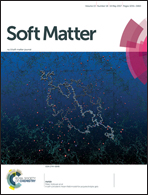A variable stiffness dielectric elastomer actuator based on electrostatic chucking†
Abstract
Dielectric elastomer actuators (DEA) are one type of promising artificial muscle; however, applications of bending-type DEA for robotic end-effectors may be limited by their low stiffness and ability to resist external loads without buckling. Unimorph DEA can produce large out-of-plane deformation suitable for use as robotic end effectors; however, design of such actuators for large displacement comes at the cost of low stiffness and blocking force. This work proposes and demonstrates a variable stiffness dielectric elastomer actuator (VSDEA) consisting of a plurality of unimorph DEA units operating in parallel, which can exhibit variable electrostatic chucking to modulate the structure's bending stiffness. The unimorph DEA units are additively manufactured using a high-resolution pneumatic dispenser, and VSDEA comprising various numbers of units are assembled. The performance of the DEA units and VSDEA are compared to model predictions, exhibiting a maximum stiffness change of 39.2×. A claw actuator comprising two VSDEA and weighing 0.6 grams is demonstrated grasping and lifting a 10 gram object.



 Please wait while we load your content...
Please wait while we load your content...